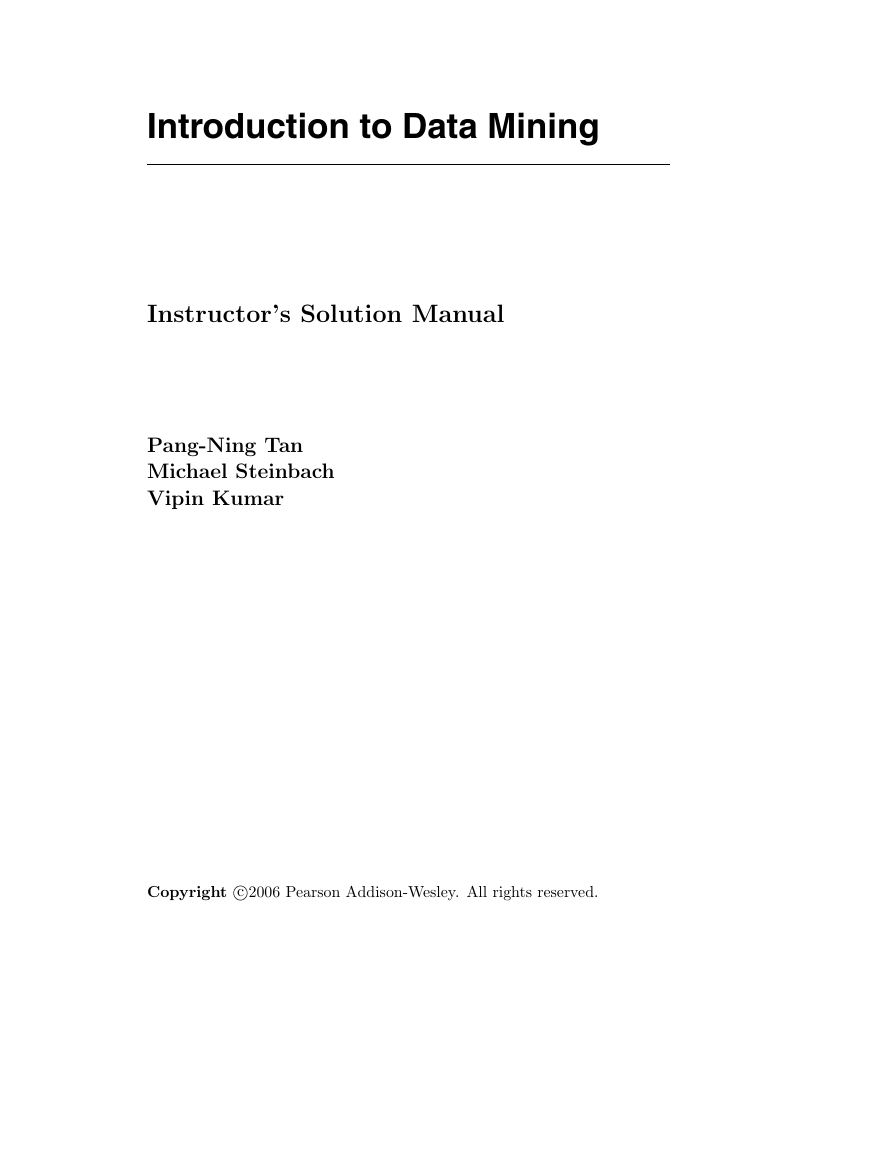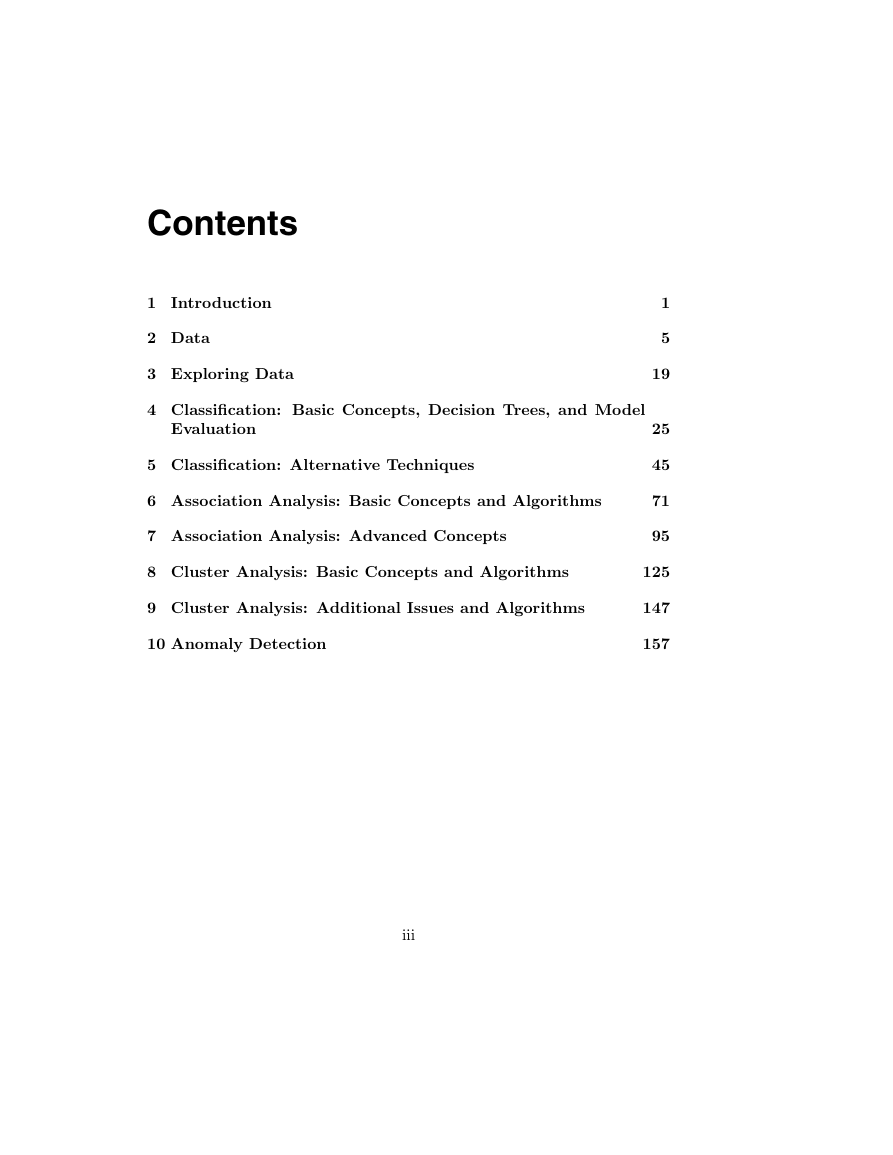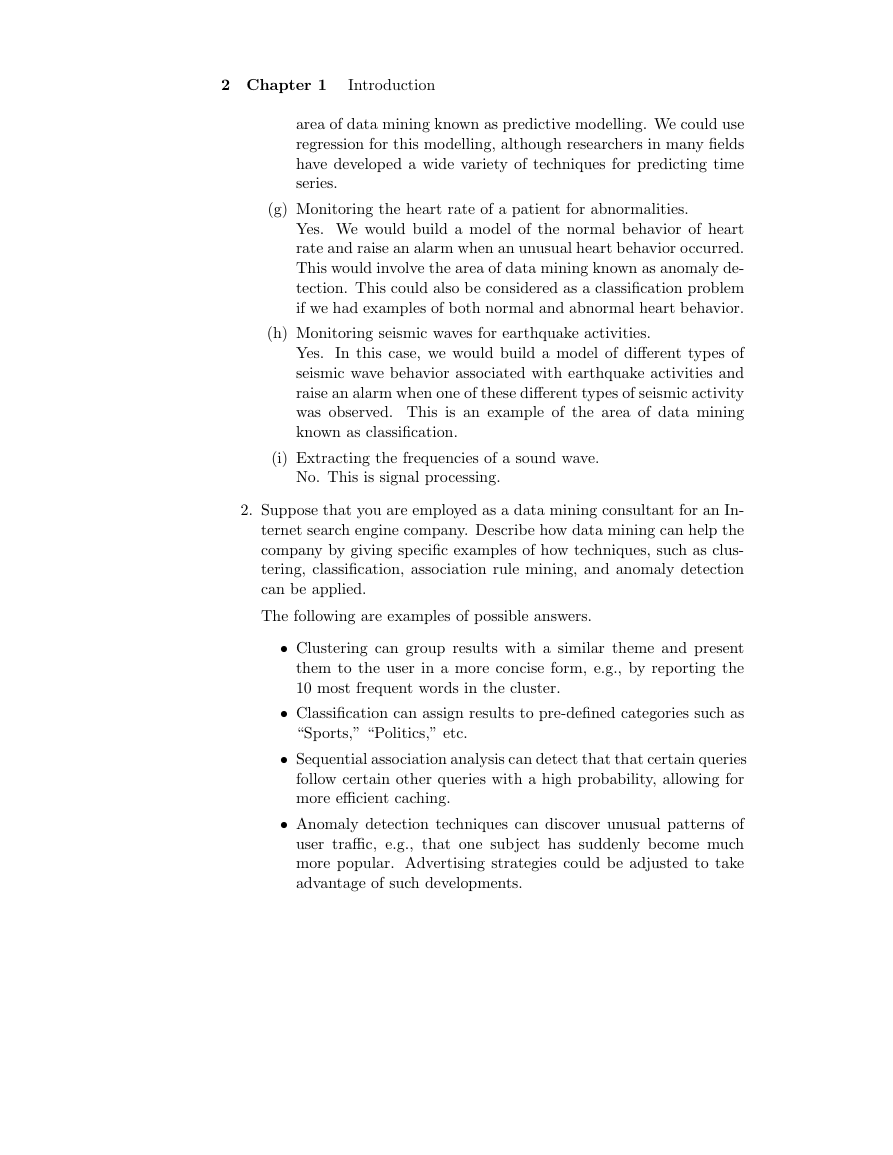Introduction to Data Mining
Instructor’s Solution Manual
Pang-Ning Tan
Michael Steinbach
Vipin Kumar
Copyright c2006 Pearson Addison-Wesley. All rights reserved.
�
�
1
5
19
25
45
71
95
125
147
157
Contents
1 Introduction
2 Data
3 Exploring Data
4 Classification: Basic Concepts, Decision Trees, and Model
Evaluation
5 Classification: Alternative Techniques
6 Association Analysis: Basic Concepts and Algorithms
7 Association Analysis: Advanced Concepts
8 Cluster Analysis: Basic Concepts and Algorithms
9 Cluster Analysis: Additional Issues and Algorithms
10 Anomaly Detection
iii
�
�
1
Introduction
1. Discuss whether or not each of the following activities is a data mining
task.
(a) Dividing the customers of a company according to their gender.
No. This is a simple database query.
(b) Dividing the customers of a company according to their prof-
itability.
No. This is an accounting calculation, followed by the applica-
tion of a threshold. However, predicting the profitability of a new
customer would be data mining.
(c) Computing the total sales of a company.
No. Again, this is simple accounting.
(d) Sorting a student database based on student identification num-
bers.
No. Again, this is a simple database query.
(e) Predicting the outcomes of tossing a (fair) pair of dice.
No. Since the die is fair, this is a probability calculation. If the
die were not fair, and we needed to estimate the probabilities of
each outcome from the data, then this is more like the problems
considered by data mining. However, in this specific case, solu-
tions to this problem were developed by mathematicians a long
time ago, and thus, we wouldn’t consider it to be data mining.
(f) Predicting the future stock price of a company using historical
records.
Yes. We would attempt to create a model that can predict the
continuous value of the stock price. This is an example of the
�
2 Chapter 1
Introduction
area of data mining known as predictive modelling. We could use
regression for this modelling, although researchers in many fields
have developed a wide variety of techniques for predicting time
series.
(g) Monitoring the heart rate of a patient for abnormalities.
Yes. We would build a model of the normal behavior of heart
rate and raise an alarm when an unusual heart behavior occurred.
This would involve the area of data mining known as anomaly de-
tection. This could also be considered as a classification problem
if we had examples of both normal and abnormal heart behavior.
(h) Monitoring seismic waves for earthquake activities.
Yes. In this case, we would build a model of different types of
seismic wave behavior associated with earthquake activities and
raise an alarm when one of these different types of seismic activity
was observed. This is an example of the area of data mining
known as classification.
(i) Extracting the frequencies of a sound wave.
No. This is signal processing.
2. Suppose that you are employed as a data mining consultant for an In-
ternet search engine company. Describe how data mining can help the
company by giving specific examples of how techniques, such as clus-
tering, classification, association rule mining, and anomaly detection
can be applied.
The following are examples of possible answers.
“Sports,” “Politics,” etc.
• Clustering can group results with a similar theme and present
them to the user in a more concise form, e.g., by reporting the
10 most frequent words in the cluster.
• Classification can assign results to pre-defined categories such as
• Sequential association analysis can detect that that certain queries
follow certain other queries with a high probability, allowing for
more efficient caching.
• Anomaly detection techniques can discover unusual patterns of
user traffic, e.g., that one subject has suddenly become much
more popular. Advertising strategies could be adjusted to take
advantage of such developments.
�
3
3. For each of the following data sets, explain whether or not data privacy
is an important issue.
(a) Census data collected from 1900–1950. No
(b) IP addresses and visit times of Web users who visit your Website.
Yes
(c) Images from Earth-orbiting satellites. No
(d) Names and addresses of people from the telephone book. No
(e) Names and email addresses collected from the Web. No
�
�
















 2023年江西萍乡中考道德与法治真题及答案.doc
2023年江西萍乡中考道德与法治真题及答案.doc 2012年重庆南川中考生物真题及答案.doc
2012年重庆南川中考生物真题及答案.doc 2013年江西师范大学地理学综合及文艺理论基础考研真题.doc
2013年江西师范大学地理学综合及文艺理论基础考研真题.doc 2020年四川甘孜小升初语文真题及答案I卷.doc
2020年四川甘孜小升初语文真题及答案I卷.doc 2020年注册岩土工程师专业基础考试真题及答案.doc
2020年注册岩土工程师专业基础考试真题及答案.doc 2023-2024学年福建省厦门市九年级上学期数学月考试题及答案.doc
2023-2024学年福建省厦门市九年级上学期数学月考试题及答案.doc 2021-2022学年辽宁省沈阳市大东区九年级上学期语文期末试题及答案.doc
2021-2022学年辽宁省沈阳市大东区九年级上学期语文期末试题及答案.doc 2022-2023学年北京东城区初三第一学期物理期末试卷及答案.doc
2022-2023学年北京东城区初三第一学期物理期末试卷及答案.doc 2018上半年江西教师资格初中地理学科知识与教学能力真题及答案.doc
2018上半年江西教师资格初中地理学科知识与教学能力真题及答案.doc 2012年河北国家公务员申论考试真题及答案-省级.doc
2012年河北国家公务员申论考试真题及答案-省级.doc 2020-2021学年江苏省扬州市江都区邵樊片九年级上学期数学第一次质量检测试题及答案.doc
2020-2021学年江苏省扬州市江都区邵樊片九年级上学期数学第一次质量检测试题及答案.doc 2022下半年黑龙江教师资格证中学综合素质真题及答案.doc
2022下半年黑龙江教师资格证中学综合素质真题及答案.doc